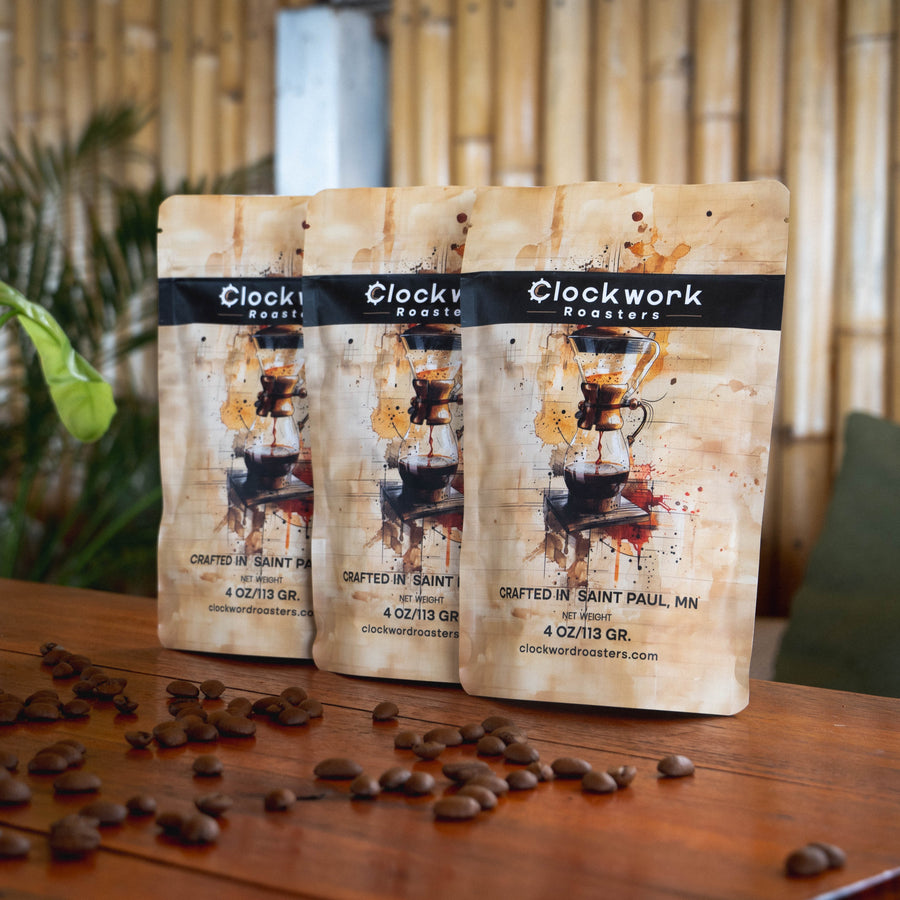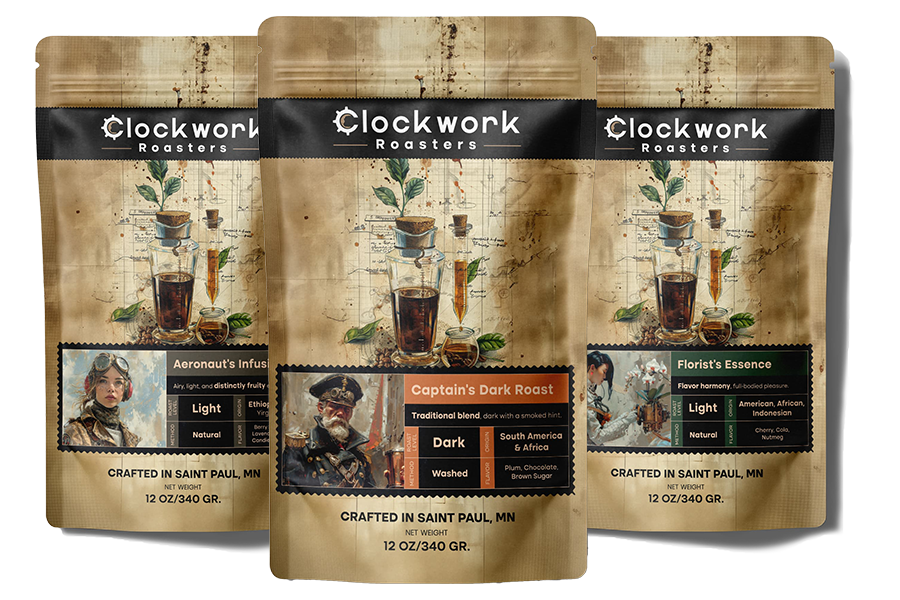Grinding for Great Coffee: Matching Your Grind to Your Brewing Method

Grinding for Great Coffee: Matching Your Grind to Your Brewing Method
Why grind size matters
Grinding is one of the most critical steps between roasted bean and your cup. The grind size determines how fast water can extract soluble flavors (sugars, acids, oils)—too coarse and the water flows through too fast (under-extracted, weak, sour), too fine and flow is too slow (over-extracted, bitter). Also, the roast profile (light, medium, dark), bean origin, freshness, and brew temperature all interact with grind size.
Clockwork Roasters emphasizes freshness (“roasted and shipped from Saint Paul Minnesota” etc.) and high quality organic beans. Using fresh beans means grind size becomes even more important because fresh roasted beans off-gas and retain volatile aroma compounds. Getting grind right helps unlock what they roast into the bean. (Clockwork Roasters)
General Grind Size Guide by Brewing Method
Below is a guide to common brewing methods and what kind of grind works well. Then I’ll give concrete examples using Clockwork Roasters’ beans so you can try at home.
| Brewing Method | Typical Time / Contact | Water Flow / Resistance | Grind Size / Texture | Why This Works |
|---|---|---|---|---|
| Coarse (like sea salt to very chunky) | Long contact or steep (e.g. cold brew: 12-24 h; French press: 4-5 min) | Low resistance; you want water to pass slowly through big gaps | Very coarse to coarse, roughly like coarse sea salt or even larger chunks | Prevents over-extraction; slows extraction just enough so you get full body without bitterness |
| Medium-coarse | Chemex, Clever drip, some pour overs (longer drips) | Moderate flow; some resistance but not too much | Like rough sand / coarse sugar | Balances extraction: enough contact time to draw out flavors without over-steeping |
| Medium | Drip coffee machines, standard V60 pour overs, AeroPress with standard setting | Balanced; moderate resistance | Like regular sand or table sugar | Good general extraction; sweet, clean, with clarity |
| Medium-fine | AeroPress (shorter times), smaller pour-over cone, moka pot (on edge) | More resistance; water moves slower | Slightly finer than table sugar; think fine sand | Extracts flavors more fully in less time; can enhance body and richness |
| Fine / Espresso | Espresso machine, Turkish coffee | Very high resistance; very short contact (20-30 sec for espresso) | Like powdered sugar, or very fine flour for Turkish | Required to force enough extraction in the short period; must avoid channeling, tamping well, etc. |
Using Clockwork Roasters Beans: Examples & Tips
Clockwork offers several roast styles and origins (light, medium, dark; various flavor signatures) that lend themselves to specific brewing adjustments. Here are a few examples and what grind settings I’d suggest:
| Bean / Roast | Flavor Profile Notes* | Best Brewing Methods | Suggested Grind Size | Why This Pairing Works |
|---|---|---|---|---|
| Ethiopia Aeronaut’s Infusion (Light, Natural) – “airy, light, and distinctly fruity experience” (Clockwork Roasters) | Bright acidity, delicate fruit notes; more subtle oils and aromatics | Pour-over (V60, Chemex), AeroPress at moderate steep / pour time, maybe cold brew if you want to bring out juicy fruit with sweeter finish | Medium to medium-fine: similar to table sugar or slightly finer | To accentuate fruit and floral tones without letting harsh acidic or vegetal tones dominate. A coarser grind might under-extract and miss sweetness; too fine may bring out bitterness. |
| *Signature Blend Medium roast (“Alchemist’s Infusion”) * – balanced profile, perhaps more body and sweetness with subtle roast flavors (Clockwork Roasters) | Balanced acidity, more of the roast / sugar / body interplay | Drip machines, V60, also French press if you enjoy more body, maybe pourover filters that emphasize clarity | Medium to medium-coarse: like coarse sand or slightly rough sugar | Allows flavors to unfold, balancing clarity (not muddy) and body. Medium allows good extraction of sugars; coarser for more body and less sharpness. |
| *Espresso / Dark Roast (“Quick Peak Espresso Roast” or a dark roast blend) * – creamy, strong, maybe chocolate / caramel / deeper roast notes (Clockwork Roasters) | Less acidity, more caramelization, oils more pronounced | Espresso machine, moka pot; possibly short AeroPress; if trying drip, use medium-fine to bring out roast sweetness | Fine: close to powdered sugar; for espresso very fine and consistent, with good tamp / pressure | Fine grind slows the flow, giving short exposure time but high extraction. Ensures crema, body, richness. Too coarse will gush through with weak flavor. |
*Flavor profile notes drawn from Clockwork’s product descriptions — always experiment a bit; beans vary batch to batch.
Practical Tips & Calibration
-
Start with a baseline: Pick a brew method, use a medium grind, taste. If it tastes sour / under-extracted → finer or slower. If it’s bitter / over-extracted → coarser or faster.
-
Consistency matters: Use a good burr grinder, not blade. Uniform particle size helps predictable extraction.
-
Adjust with freshness: With freshly roasted beans (as Clockwork claims), you may want a slightly coarser grind than for stale beans, because fresh ones release gases and can resist water a bit more.
-
Water temperature and brew time: If your water is cooler, you might need finer grind or longer contact time. Vice versa, hotter water allows a coarser grind (within reason).
-
Filter / brew equipment differences: Paper vs metal filters, cone vs flat-bed, pressure, etc., all affect extraction. Always taste and adjust.
Conclusion
Getting your grind size right for your brewing method is a powerful lever for making your coffee taste its best. With Clockwork Roasters’ variety — from light, fruity naturals like Ethiopia Aeronaut’s Infusion to rich darker blends or espresso roasts — you have lots of room for fine-tuning.
Try:
-
For a light Ethiopia, grind just a touch finer than you might normally for a pour-over, use slightly longer contact or slower pour.
-
For a darker espresso or Quick Peak roast, push toward fine, ensure pressure, tamping, consistency, and experiment with dose/temperature.








Leave a comment